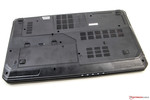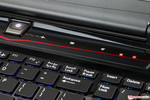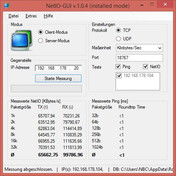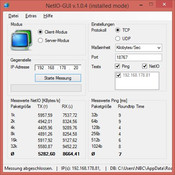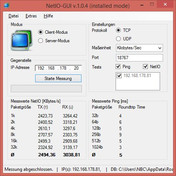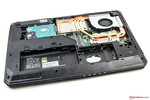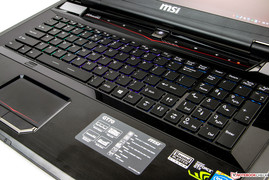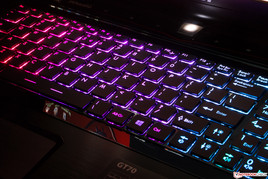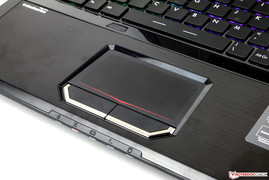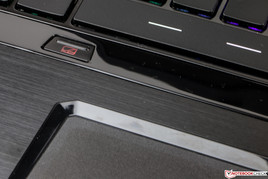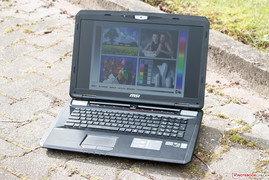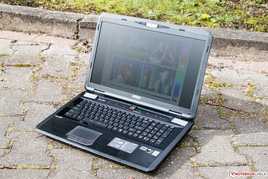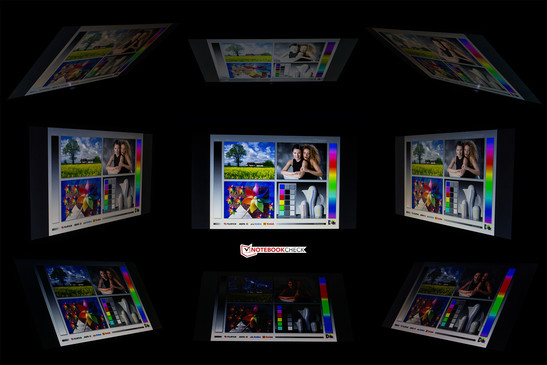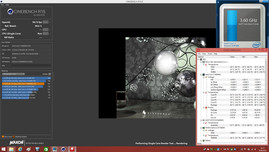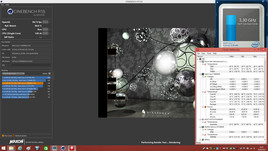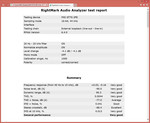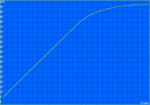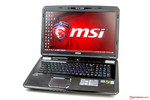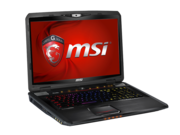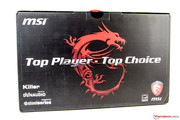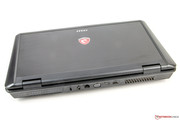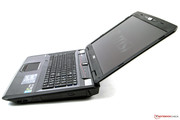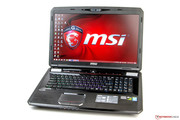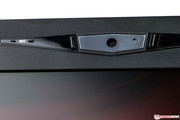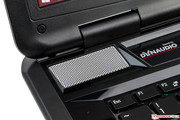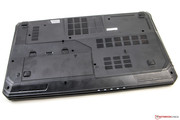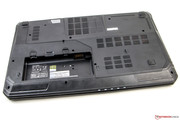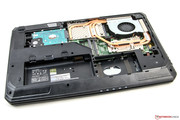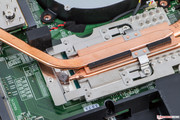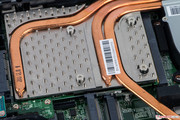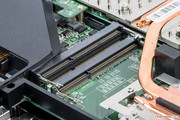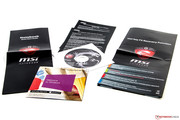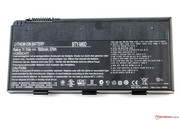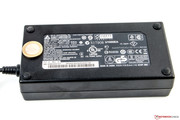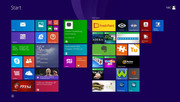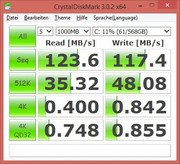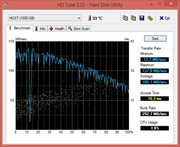Review MSI GT70 2PE-890US Gaming Notebook

For the original German review, see here.
The MSI GT70 2PE-890US is equipped with one of the fastest graphics cards Nvidia has to offer for mobile devices. We tested a model of this series last year: the MSI GT70H-80M4811B. The predecessor was equipped with a quad-core CPU (Core i7-4700MQ) of the Haswell generation and an Nvidia GeForce GTX 780M GPU. Overall, it was a well-rounded laptop with a single glaring flaw: single-channel RAM. This resulted in an unnecessary drop in the performance of the IGP.
The Taiwanese manufacturer has rectified this mistake and the new test model is equipped with 12 GB DDR3 RAM. The CPU is stronger and the NVIDIA GPU uses the latest technology. The test model is the US version, which means it has a slightly different keyboard layout. The European models will be delivered with the layouts appropriate for their country. Currently, there is no configuration available on the European market that matches our test model. We noticed small differences: for example, our test model is similar to the MSI GT70-2PE12H11 (1,849 Euros; ~$2565), which has an additional SSD.
Competitors like the Schenker XMG P704 and the One K73-4N have similar hardware. The One K56-4N uses the Radeon R9 M290X from AMD. In this review, we will examine how the MSI GT70 2PE-890US performs in comparison to its competitors.
Case
Like the predecessor, the test model employs the Barebones MS-1763. The laptop weighs 3.8 kilograms (~8.4 pounds) and looks the same on the outside. The illuminated logo on the back is the only change on the aluminum cover of the notebook.
The relatively heavy case is very rigid. The choice of materials is good: aluminum is used for the display cover and the hand-rest regions and the rest is made of synthetic material. The design is a matter of taste.
The display border is made of matte synthetic material. Unfortunately, the keyboard and the sensor panel above it are made of glossy surfaces. These attract dust, smudges and fingerprints. Overall, the construction is sturdy.
Connectivity
The distribution of ports has its pros and cons. The ports on the right and left side are placed quite close to the front. If the user uses many of these ports, then left-handed users can end up lacking space to move their external mouse. As the GT70 2PE-890US is designed to be a DTR (desktop replacement), we like that the video interfaces, the LAN port, power outlet and Kensington Lock are placed on the back.
Like in the predecessor, the manufacturer uses the MSI Matrix display. This allows the user to utilize all video outputs simultaneously, which means up to four displays can be used alongside the notebook panel in Full HD.
The four audio jacks are included and allow the user to connect headphone, microphone and a 7.1 Surround Sound (analog) system.
Communication
The communication modules are all from Qualcomm. The Gigabit-LAN Controller Killer e2200 ensures low latency while gaming. The speed and latency times of the e2200 are quite good, but they cannot surpass the modules in other models.
The WLAN is an Atheros Killer Wireless-N 1202. This module supports the IEEE-802.11 standards a/b/g/n and operates on the 2.4 and 5.0 GHz frequencies. We tested the module (desktop PC to router: Fritz!Box 6360) to check its transfer rates. The rates are good, but we could not find very low latency times. The module continues to perform well at long ranges (10 meters; ~33 feet). The connection quality of the WLAN is good.
Bluetooth 4.0 is included and the streaming of audio works without issues.
Accessories
The delivery of the MSI GT70 2PE-890US includes little besides the laptop and the 180 W power adapter (19.5 Volt, 9.2 Ampere, 847 grams; ~1.9 lbs): a few colorful pages, a short manual and the warranty card. A DVD is provided and it contains the extensive user manual, the preinstalled software and the required drivers. The drivers are only for Windows 8.1 and drivers for Windows 7 are not included.
Maintenance
Maintenance of the MSI GT70 2PE-890US is easy: a large maintenance flap on the bottom allows us to access the internal hardware. The fan is easy to clean out. The cooling system for the CPU and GPU is very good, but it can be swapped out by experienced users.
The preinstalled RAM can be found under the keyboard. The keyboard will have to be removed to reach it and a short manual can be found in our review of the MSI GT70H. The two free slots are easy to reach via the bottom flap.
The installation of the hard disks has changed slightly. Our test model already has a 2.5-inch HDD and a free slot is available for another storage device. The predecessor had three free mSATA slots in this area. MSI still advertises this feature on its website so it must be available in a different configuration (perhaps one with Super Raid 2).
Warranty
MSI provides the gaming notebook with a 24-months warranty. The power adapter and battery are insured for 12 months. If you require more, take a look at the online shop of the manufacturer. It is possible to extend the warranty up to 36 months. This will cost an extra 139 Euros (~$193).
Input Devices
Keyboard
The chiclet keyboard of the MSI GT70 2PE-890US was specially designed for gamers. This is a SteelSeries keyboard, with a focus on the WASD keys and an optimized layout for gamers. The left CTRL key and the space bar have been improved to allow the user to use them with a single hand. The Windows key had to be pushed to the side to prevent accidentally tabbing out of games. The smaller Enter key is a matter of taste and requires getting used to.
The QWERTY keys measure 14.5 x 14.5 mm and have a decent stroke distance as well as good feedback. The typing noise could have been quieter. The numeric block is useful, but the smaller zero key requires some getting used to. Up to ten key presses are recognized simultaneously.
The backlight of the keyboard is like that of the predecessor. It is distributed in three zones, which allow the user to freely pick out the colors. Additional effects are also available, for example, a pulsing light effect. The illumination is balanced and ensures good legibility. It is a pity that the user has to wait a little while for the backlight to kick in after starting the computer.
The touch-sensitive input surfaces, above the keyboard, allow the user to open certain programs and run functions. PowerDVD 10 can be opened in full screen and the Cooler Boost 2 can be activated. The user can also turn on flight mode as well as switch between the illumination schemes for the keyboard. Furthermore, the display can be turned off via these hotkeys and the Dragon Gaming Center can be opened.
Touchpad
The touchpad of the MSI GT70 originates from Synaptics and is quite small for a 17.3-inch notebook: 84 x 42 mm (~3.3 x 1.7 in). The touchpad is deeply recessed and has a rough surface, which allows the user to find it even with their eyes closed. The sliding properties are good and the input is executed well. Due to the small size of the device, the user might accidentally end up displaying Charms in Windows. The multi-touch gesture support is good and the separate mouse keys are a little spongy, but easy to click.
The touchpad can be turned off via a button above it. If an external mouse is connected, the laptop automatically turns off the touchpad.
Display
The display of the MSI GT70 2PE-890US measures 17.3 inches and has a 1,920x1,080 pixel resolution (Full HD). This translates to a ratio of 16:9 and a pixel density of 127 PPI. The matte panel is named N173HGE-L11 and originates from CHIMEI. The Taiwanese manufacturer has picked the same panel series as their competitors One K73-4N and Schenker XMG P704.
The brightness lies at a similar level and our test model offers a maximum of 326 cd/m². The illumination is balanced at 83%. We did not notice any major discrepancies in the brightness in different areas of the panel.
| |||||||||||||||||||||||||
Brightness Distribution: 83 %
Center on Battery: 324 cd/m²
Contrast: 926:1 (Black: 0.35 cd/m²)
ΔE Color 10.55 | 0.5-29.43 Ø5
ΔE Greyscale 11.01 | 0.57-98 Ø5.3
54% AdobeRGB 1998 (Argyll 1.6.3 3D)
61.3% AdobeRGB 1998 (Argyll 2.2.0 3D)
84.6% sRGB (Argyll 2.2.0 3D)
60.2% Display P3 (Argyll 2.2.0 3D)
Gamma: 2.62
The black value of 0.35 cd/m² is quite good and is rare to find in TN panels. The contrast ratio is 926:1 and offers no room for complaint.
The color accuracy of the display is not so important for most gamers, but according to our tests, the display has some weaknesses with its factory settings. It has a visible blue tinge, which makes the panel look cool. However, this is only noticeable if you compare it to another laptop and it can be alleviated with calibration. Professional picture editing is not possible at a mere 73% coverage of the sRGB color spectrum.
Outdoor use of the MSI GT70 2PE-890US should be fine. The high brightness, strong contrast and matte surface allow us to view content without issues, even in a bright environment. However, direct sunlight can strain the eyes after a while.
The viewing angles of the TN panel are good, but do not even come close to those of an IPS screen. Changes in the viewing angle horizontally, results in minimal drops in brightness, which means that watching a film with a group of people should be fine. Vertically, changes in the viewing angle results in the drops in contrast and color inverting typical to TN displays. However, these panels offer a faster reaction time, which is important for gamers.
Performance
The performance of a gaming notebook is definitely important. MSI has installed a strong quad-core CPU, from the Intel Haswell generation and a fast Nvidia GeForce GTX 880M for processing high-end graphics effects. The 12 GB DDR3L RAM is unusual, but more than enough for our needs.
Processor
The CPU of the MSI GT70 2PE-890US is an Intel Core i7-4800MQ. This quad-core processor has a base clock speed of 2.7 GHz and can process up to eight threads simultaneously. Turbo Boost 2.0 allows the CPU to boost up to 3.7 GHz (single-core). While using two cores, the Turbo raises the speed up to a maximum of 3.6 GHz and for four cores it speeds up to a maximum of 3.5 GHz.
The benchmark results of Cinebench R15 are quite good and at the expected level. The Core i7 of our test model scores 142 points in the single-core test and 680 points in the multi-core test. The XMG P704 (Core i7-4910MQ) is a bit better off thanks to its stronger processor. The result could have been better, but the test model experienced slight fluctuations in its clock speed in both tests. When all cores are used during the test, the speed drops to 3.3 GHz.
| Cinebench R15 | |
| CPU Single 64Bit (sort by value) | |
| MSI GT70 2PE-890US | |
| One K56-4N | |
| One K73-4N | |
| SCHENKER XMG P704 | |
| CPU Multi 64Bit (sort by value) | |
| MSI GT70 2PE-890US | |
| One K56-4N | |
| One K73-4N | |
| SCHENKER XMG P704 | |
Processor Turbo
Like in the Cinebench R15, the Intel Core i7-4800MQ cannot always offer its maximum clock speed in the MSI GT70 2PE via Turbo Boost. We took a closer look using Prime 95 and stress testing. The clock speed of the processor dropped immediately down to 3.2 GHz. However, this is not the fault of the manufacturer, as in reality it is the CPU that is hitting its TDP value of 47 W. The temperatures rise up to 84 °C (183.2 °F), which is not a critical level. Turning on MSI Cooler Boost 2, will drop the temperatures down to 67 °C (152.6 °F), but the clock speed stays the same. It does not even change while the laptop runs on battery. The CPU stays stable in the Turbo range.
System Performance
The system performance of the MSI GT70 2PE-890US is quite good even without a fast SSD. This is confirmed by PCMark 7, in which the system scores a decent 3,566 points. Without fast storage, it is hard to break the 4k mark. As such, all competitors score higher as they use fast storage devices.
If you own a notebook with an SSD, you will surely miss it in this laptop. The European configuration usually comes with one, but otherwise we recommend installing one.
| PCMark 7 Score | 3566 points | |
| PCMark 8 Home Score Accelerated v2 | 3978 points | |
| PCMark 8 Creative Score Accelerated v2 | 5443 points | |
| PCMark 8 Work Score Accelerated v2 | 4491 points | |
Help | ||
Storage Devices
The storage device used in the MSI GT70 2PE-890US is an HGST Travelstar 7K1000. This traditional hard disk runs at 7,200 rpm and is thus quite fast. The performance is especially good in the sequential read and write tests and it clearly surpasses HDD’s that operate at 5,400 rpm. The access times of 16 ms are quite high, especially when compared to the times of the storage devices found in the competition.
The biggest advantage of this package is the storage capacity of one TB (of which 820 GB is free). The rest of the space is taken by the operating system, the preinstalled software and the recovery partition.
Graphics Card
The MSI GT70 2PE-890US has two graphics cards. The Intel HD Graphics 4600 takes care of the everyday tasks like surfing the web or working with office. Thanks to Quick Sync, the CPU can efficiently convert videos. The conservative GPU operates between 200 and 1,300 MHz. It lacks its own memory. Thanks to Nvidia Optimus, the system can automatically switch from the IGP to the stronger, dedicated GPU.
The Nvidia GeForce GTX 880M belongs currently to the strongest GPUs. It is based on the GK104 chip with Kepler architecture like its predecessor the GTX 780M. It runs at 954 MHz, around 15% faster, and can increase the speed thanks to Boost. The eight shaders each have 192 CUDA cores, which means the GTX 880M has a total of 1,536 shaders. The memory interface is 256-bit. Furthermore, the GPU has 8 GB GDDR5 RAM, which runs at 2,500 MHz. Battery Boost allows the battery life to be increased while gaming.
The 3DMark benchmark (2013) shows what the GTX 880M can do. The Fire Strike Graphics score is 6,197 points. It is even faster than the GPU of the XMG P704 (6,095 points), although they use the same driver (ForceWare 332.35). The competition, using the AMD GPU, cannot hold its own. The One K56-4N uses a Radeon R9 M290X. The AMD GPU lies further behind at 5,294 points (-15%) and is closer to the standard of the predecessor. The GPU of the test model is one of the strongest single-chip GPUs.
The clock speed was measured using Unigine Heaven 4.0 (1,366x768 pixels, Ultra-Quality, Extreme-Tessellation, 8xAA, Dx11). Everything runs fluidly at 78 fps. The GTX 880M runs at 993 MHz and drops down to 967 MHz for brief periods, but as such remains in the Turbo range throughout. MSI Cooler Boost 2 drops the temperature of the GPU from 87 °C (188.6 °F) to 79 °C (174.2 °F). The clock speed is dropped to 980 MHz only briefly. On battery, the clock speed ranges between 745 and 797 MHz. The frame rates drop below 30 fps.
| MSI GT70 2PE-890US GeForce GTX 880M, 4800MQ, HGST Travelstar 7K1000 HTS721010A9E630 | One K73-4N GeForce GTX 870M, 4800MQ, Samsung SSD 840 EVO 500GB | MSI GT70H-80M4811B GeForce GTX 780M, 4700MQ, SanDisk X100 128GB SD5SF2128G1014E | One K56-4N Radeon R9 M290X, 4700MQ, Samsung SSD 840 EVO 500GB | SCHENKER XMG P704 GeForce GTX 880M, 4910MQ, Crucial M500 480 GB CT480M500SSD3 mSATA | |
|---|---|---|---|---|---|
| 3DMark | -20% | -16% | -13% | -2% | |
| 1920x1080 Fire Strike Score | 5577 | 4261 -24% | 4631 -17% | 4793 -14% | 5493 -2% |
| 1920x1080 Fire Strike Graphics | 6197 | 4664 -25% | 5104 -18% | 5294 -15% | 6095 -2% |
| 1920x1080 Fire Strike Physics | 9754 | 9225 -5% | 8813 -10% | 8810 -10% | 9775 0% |
| 1920x1080 Fire Strike Combined | 2332 | 1737 -26% | 1925 -17% | 2004 -14% | 2292 -2% |
| 3DMark 06 Standard Score | 28118 points | |
| 3DMark 11 Performance | 8148 points | |
| 3DMark Ice Storm Standard Score | 82289 points | |
| 3DMark Cloud Gate Standard Score | 19781 points | |
| 3DMark Fire Strike Score | 5577 points | |
| 3DMark Fire Strike Extreme Score | 2774 points | |
Help | ||
Gaming Performance
The Nvidia GeForce GTX 880M is currently one of the strongest single-chip GPUs available. As such, the MSI GT70 2PE-890US has up to 15% more performance available than its predecessor. This is confirmed by the benchmarks: although the performance increase is not as great as it was last year, it is still enough to beat the AMD Radeon R9 M290X.
The strong graphics card can even run most games at ultra settings (Full HD resolution, max details, AA). This includes Company of Heroes 2, which is very performance-hungry. Still, the user will get a high-performance gaming machine.
The MSI Cooler Boost 2 has no direct influence on the benchmark results, but it does offer an improved cooling system, and thus presents the option of reaching even higher frame rates with overclocking.
| Battlefield 4 - 1920x1080 Ultra Preset AA:4x MS (sort by value) | |
| MSI GT70 2PE-890US | |
| One K73-4N | |
| One K56-4N | |
| SCHENKER XMG P704 | |
| Metro: Last Light - 1920x1080 Very High (DX11) AF:16x (sort by value) | |
| MSI GT70 2PE-890US | |
| One K73-4N | |
| One K56-4N | |
| MSI GT70H-80M4811B | |
| Asus G750JH-T4080H | |
| SCHENKER XMG P704 | |
| Company of Heroes 2 - 1920x1080 Maximum / Higher / High AA:High (sort by value) | |
| MSI GT70 2PE-890US | |
| Asus G750JH-T4080H | |
| low | med. | high | ultra | |
| The Elder Scrolls V: Skyrim (2011) | 176.2 | 165.2 | 95.1 | 64.3 |
| Diablo III (2012) | 193 | 125 | 117 | 84 |
| StarCraft II: Heart of the Swarm (2013) | 123 | 100 | 85 | 47 |
| Metro: Last Light (2013) | 106.5 | 90 | 75.9 | 42.4 |
| GRID 2 (2013) | 145.1 | 107.1 | 98.2 | 72.6 |
| Company of Heroes 2 (2013) | 55.4 | 52.8 | 46 | 24.7 |
| Total War: Rome II (2013) | 245 | 175.5 | 152 | 37 |
| Fifa 14 (2013) | 471 | 347 | 334 | 294 |
| Battlefield 4 (2013) | 181 | 149 | 125 | 51 |
| Assassin´s Creed IV: Black Flag (2013) | 62 | 59 | 57 | 35 |
Emissions
System Noise
While idle, the MSI GT70 2PE-890US is quite loud. The constantly running fan is audible at over 34 dB(A) and even drones over the HDD.
At medium load, which is simulated using 3DMark 06, the emissions of the system fluctuate between 40-47 dB(A). In this case, the fan behavior should be further optimized to achieve as stable a level as possible. At load, which we simulate using FurMark and Prime95 simultaneously, the emissions rise due to the activated Cooler Boost, up to 56 dB(A). This is really quite loud and even surpasses notebooks with a Clevo barebones, like the XMG P704 (max. 52 dB(A)). Thankfully, we reach this level of emission only when we activate the Cooler Boost. We find the Asus G750 to be ideal as even at full load it stays below 45 dB(A).
Noise Level
| Idle |
| 34.2 / 34.4 / 34.8 dB(A) |
| DVD |
| 36 / dB(A) |
| Load |
| 46.8 / 56 dB(A) |
 | ||
30 dB silent 40 dB(A) audible 50 dB(A) loud |
||
min: | ||
Temperature
The surface temperatures of the MSI GT70 2PE reach a maximum of 30.3 °C (86.54 °F) while idle, which is incredibly low. At load, the machine does not hit any critical levels, as temperatures reach a maximum of 45.4 °C (113.72 °F), near the ventilation opening. The Schenker P704 (max. 44.6 °C; 112.28 °F) performs similarly. The One K56-4N with AMD GPU reaches a maximum of 39 °C (102.2 °F) and is the coolest of all.
In the stress test, the CPU and the GPU are run at full load for multiple hours without Cooler Boost. We used Prime95 and FurMark to achieve full load. The GPU (max. 91 °C; 195.8 °F) and the CPU (max. 90 °C; 194 °F) heat up significantly, but the system stays stable. The clock speeds of the components are throttled. The processor runs at 3.0 GHz and although it is still in Turbo range, it still is far less powerful than we would expect. The graphics chip drops its speed down to 824 MHz and thus lies below its base clock speed (954 MHz). In everyday use, it would be hard to recreate this scenario, especially with this intensity. In the game benchmarks, we did not notice any limitations.
(±) The maximum temperature on the upper side is 43.5 °C / 110 F, compared to the average of 40.4 °C / 105 F, ranging from 21.2 to 68.8 °C for the class Gaming.
(-) The bottom heats up to a maximum of 45.4 °C / 114 F, compared to the average of 43.2 °C / 110 F
(+) In idle usage, the average temperature for the upper side is 25.7 °C / 78 F, compared to the device average of 33.8 °C / 93 F.
(+) The palmrests and touchpad are cooler than skin temperature with a maximum of 28.9 °C / 84 F and are therefore cool to the touch.
(±) The average temperature of the palmrest area of similar devices was 28.9 °C / 84 F (0 °C / 0 F).
Speakers
The MSI GT70 2PE-890US has an excellent audio system like its predecessor. The laptop has two speakers from Dynaudio and an integrated subwoofer, which ensures good bass. The sound of the two speakers is also quite good. High and middle notes sound good and are easily heard even at high volumes. The optimizations made to Sound Blaster Cinema are noticeable. At maximum volume, the settings need to be changed a little to optimize the sound.
The audio jacks also offer good performance. The RightMark Audio Analyzer shows that they perform quite well. The test model shows some weakness when dealing with distortions. The result is heavily dependent on the Sound Blaster Cinema settings. The results we noted were achieved without the software improvements and as such, the laptop has plenty of room for improvement.
Energy Management
Power Consumption
The MSI GT70 2PE-890US performs well in this area. While idle, the model consumes between 11 and 28 W with the Intel HD 4600. The competitors require more power. The XMG P704 is an exception as it consumes between 20 and 33 W.
At load, our dedicated graphics card takes over. This leads to even higher power consumption. While running 3DMark 06, the GT70 requires 25 W more than its predecessor (103 W) and thus lies at the same level as the One competitors (K56 and K73). In our stress test, the test model operates conservatively and consumes a "mere" 182 W. This places it at the same level as the K56-4N. The K73-4N (max. 196 W) and the P704 (max. 216 W) require even more power. The reason for this relatively low consumption is the power adapter performance of 180 W. If more power is required, the hardware uses the battery: for example, in our stress test, the battery discharged despite the laptop being connected to a power socket. A stronger power adapter would be nice, especially if the user wishes to overclock. Unfortunately, MSI does not offer one.
| Off / Standby | |
| Idle | |
| Load |
|
Battery Life
The large battery (87 Wh) allows the MSI GT70 2PE to achieve decent run times. The maximum run time was measured using the Battery Eater Reader’s test. The brightness is set to minimum and all wireless modules are turned off. The notebook lasts more than six and a half hours. In the opposite scenario, we used the Classic test from Battery Eater to measure the minimum run time, with CPU and GPU at full load and maximum brightness. The laptop lasts 71 minutes.
Our "surfing via WLAN" shows a more realistic value. In this test, the brightness is set to 150 cd/m² and all wireless modules are turned off (aside from the WLAN). The test runs a browser script, which loads a new page every 40 seconds. In this case, the GT70 shows what it can achieve with a run time of six and a half hours. This value is quite close to the max run time, which might be explained by the fact that the lowest brightness setting is still relatively high. The other competitors can achieve a maximum three and a half hours in this test. On our test model, we could play a Blu-ray for four hours. If the gaming notebook were not so big, we could have talked about the impact of such good run times on its mobility.
Verdict
The MSI GT70 2PE-890US impresses us with its strong performance, good display, great connectivity and excellent sound system. If you want performance and do not want to invest in an SLI or CrossFire system, then we recommend this test model.
The good upgrade possibilities and extensive cooling system will appeal to tweakers and overclockers equally. It is a pity that the manufacturer did not choose a stronger power adapter, which would offer more room for optimizations. The enormous emissions might be a serious issue for a few prospective buyers, especially when the system is turned up to maximum cooling. However, if you enjoy gaming with a headset, this should not disturb you. We are happy to note that the speakers are even louder than the emissions. In everyday use, this level of emissions will be hard to reach. Gaming enthusiasts will be able to look past this flaw, as the laptop is a lot of fun to use.


 Deutsch
Deutsch English
English Español
Español Français
Français Italiano
Italiano Nederlands
Nederlands Polski
Polski Português
Português Русский
Русский Türkçe
Türkçe Svenska
Svenska Chinese
Chinese Magyar
Magyar